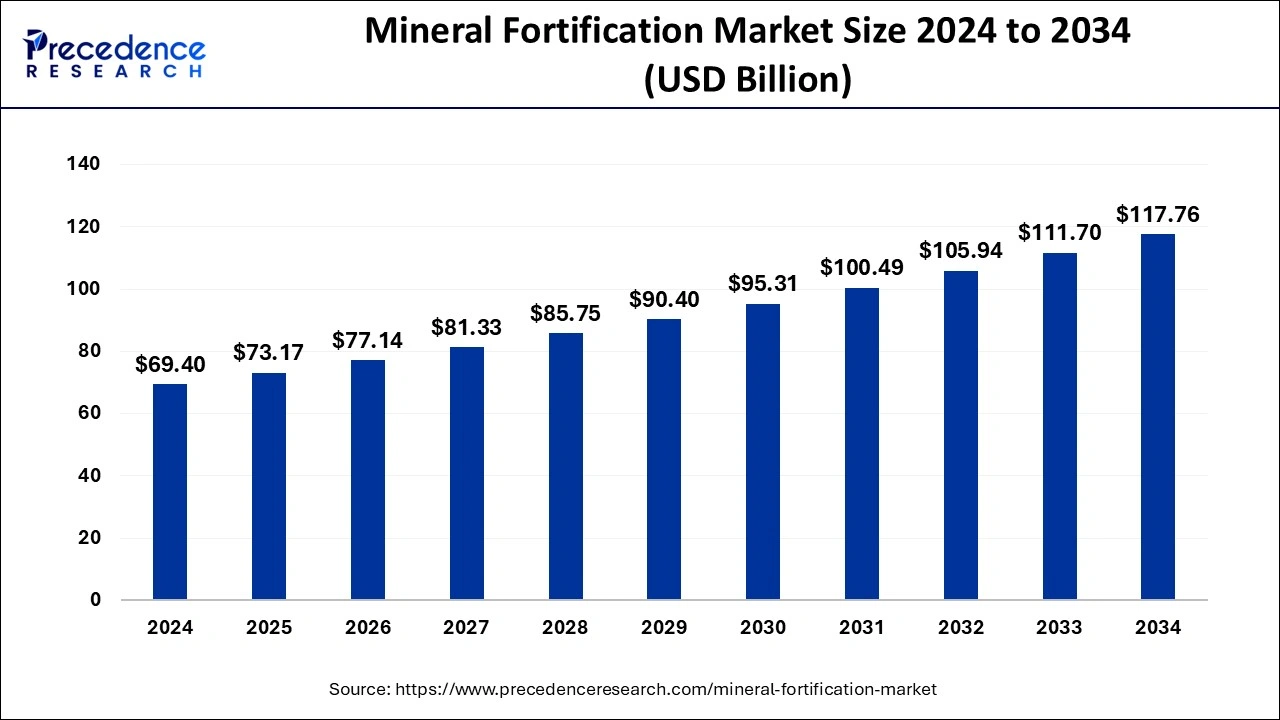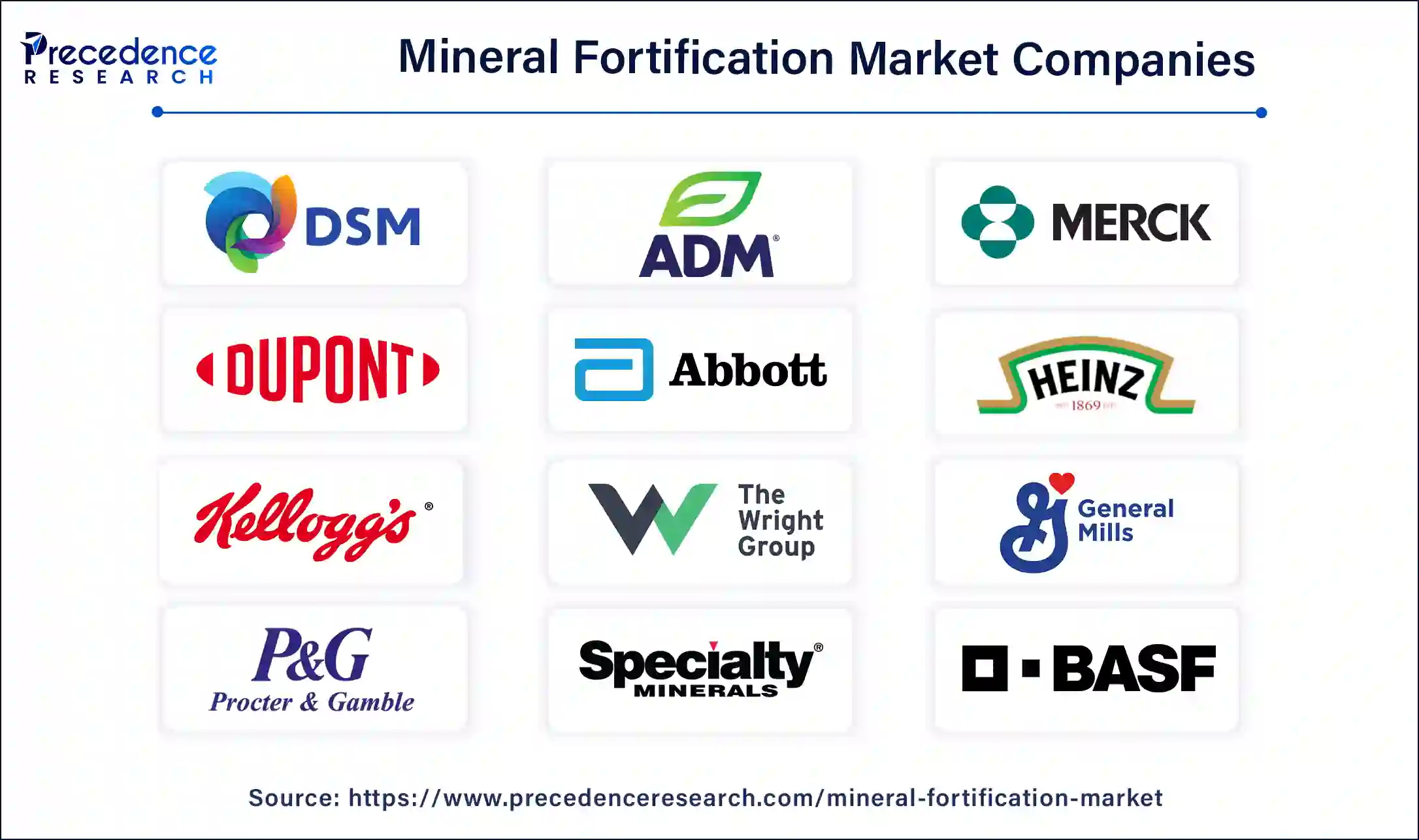October 2024
The global mineral fortification market size is predicted to hit around USD 117.76 billion by 2034 increasing from USD 69.40 billion in 2024, grew to USD 73.17 billion in 2025, registering a CAGR of 5.43% between 2025 and 2034.
The global mineral fortification market size was accounted for USD 69.40 billion in 2024 and is expected to exceed around USD 117.76 billion by 2034, growing at a CAGR of 5.43% from 2025 to 2034. The mineral fortification market is driven by the growing consumer awareness about nutrition and health.

Frequent swap in market prices has buffeted fertilizer firms, requiring new ore-processing strategies to boost long-term profitability. Major key players had already started building AI tools and agile operations capabilities in its processing. When COVID-19 struck, the company expanded these capabilities to weather the crisis. With the help of AI, it is convenient to understand correlations between market prices and profitability in different operating models. It compared the effects of maximizing production or yield with the economic life of the mine. It also looked at the effects of optimizing the grade of beneficiated ore and the impact of different ore characteristics on downstream costs.
Health concerns are bolstered by a surge in mineral-fortified products in the beverage, food, and supplement industries. For instance, osteoporosis and anemia, considered major health issues worldwide, can be mitigated through mineral fortification with essential ions such as calcium, iron, magnesium, and zinc. As populations age, it is difficult to address mineral deficiencies becomes crucial. These consumers need a source of these minerals in foods and drinks that can be easily accessible and regularly consumed.
The World Health Assembly will adopt a resolution to accelerate efforts to stop micronutrient deficiencies through safe and effective food fortification. The resolution urges Member States to decide on food fortification with micronutrients or supplementation and consider nourishing financing and monitoring mechanisms.
| Report Coverage | Details |
| Market Size by 2024 | USD 69.40 Billion |
| Market Size in 2025 | USD 73.17 Billion |
| Market Size in 2034 | USD 117.76 Billion |
| Market Growth Rate from 2025 to 2034 | CAGR of 5.43% |
| Leading Region | North America |
| Fastest Growing Region | Asia Pacific |
| Base Year | 2024 |
| Forecast Period | 2025 to 2034 |
| Segments Covered | Mineral Type, Application, and Regions |
| Regions Covered | North America, Europe, Asia-Pacific, Latin America, and Middle East & Africa |
Rising prevalence of diet-related health issues
Micronutrient malnutrition has various adverse effects on human health, not all of which are medically evident. Even moderate levels of deficiency can seriously harm human function. From a public health viewpoint, micronutrient malnutrition is a major deal not just because such huge populations are affected but also because it is a risk factor for many disorders and can contribute to high morbidity and even mortality rates.
Consumer skepticism
Numerous micronutrients work as cofactors for different enzymes in the body of humans that control vital bodily processes, including metabolism. Agriculture offers most human nutrition, mainly for individuals in developing nations. Moreover, the diet of the populace, which is approached on grains such as rice, wheat, and maize, does not provide enough of several minerals to meet daily demands, including vitamin A, calcium, iron, zinc, manganese, copper, iodine, and selenium. These nutrient-poor agricultural products can contribute to poor health, illness, higher mortality, poor growth and physical development, reduced livelihoods, and declined national socioeconomic development. Furthermore, they are unable to enhance healthy lifestyles.
Innovation in product formulations
Biotechnological processes, which use living organism derivatives, such as enzymes, are being applied to create or modify food products to optimize their functionality. Extecost-effectively contributes to the actions of probiotics in supporting the balance of intestinal flora, and it was proposed that a healthy gut could perform better mineral absorption. Dairy products with probiotics have the most developed market up to now. For instance, they added iron to a probiotic dairy drink and deliberated the effect of mineral fortification on the growth and iron status of pre-schoolers with poor micronutrients.
The iron segment held the largest share in the mineral fortification market in 2024. Iron is an essential mineral that maintains healthy blood. Its deficiency causes anemia. The WHO has published new hemoglobin cutoff points for defining and measuring anemia. The incidence of anemia was 61.4%. It is the most familiar nutritional deficiency globally, causing extreme fatigue and lightheadedness. It can affect all ages, including children, pregnant or menstruating women, and people receiving kidney dialysis.
Iron deficiency among young children can be stopped by educating families about child nutrition and ensuring adequate intake of age-appropriate iron-rich solid foods, such as iron-fortified cereals, and foods that enhance iron absorption, such as vitamin C-rich fruits, vegetables, and juices.
The zinc segment is observed to be the fastest growing in the mineral fortification market during the forecast period. Zinc is an important mineral that leads to various cellular functions, including immune system functioning, wound healing, cell division, protein and DNA synthesis, and enzyme activity. Studies show that zinc has antibacterial and anti-inflammatory properties that may help reduce acne. Zinc may also lower oil production on the skin and has a broad range of critical biological functions that stretch all life stages and basic functions, including reproduction, growth, neurological, metabolism, and immune functions.
Zinc deficiency is widespread among populations globally and, thus, underlies much of the global load of malnutrition. Therefore, zinc fortification strategies, i.e., fortification or biofortification of staple foods such as rice, maize, or wheat, will likely improve the zinc intakes of vulnerable populations across the world.
The calcium segment shows a significant growth in the mineral fortification market during the forecast period. Low dietary calcium is familiar in many populations, contributing to nutritional rickets in children and adults and increasing the risk of different health problems. Calcium is a concern as the recommended nutrient requirements are difficult to encounter without dairy products. Calcium supplementation in pregnant women has been seen to reduce the severity of complications of preeclampsia, which is a lifeâ€threatening condition for both mother and infant. Moreover, in the case of bone health, calcium has several vital functions, such as blood clotting, muscle contraction, cell adhesion, activation of enzymatic reactions, hormone and neurotransmitter release, and glycogen metabolism.
The food segment held the largest share in the mineral fortification market in 2024. Fortified foods have added nutrients that don’t naturally occur in the food. These foods are meant to enhance nutrition and add health benefits. For instance, milk is generally fortified with vitamin D, and calcium may be added to fruit juices. Enriched food means that nutrients lost during processing are added back in. Many refined grains are enriched. Wheat flour, for instance, may have riboflavin, folic acid, and iron added back in after processing. This is intended to generate its original vitamin levels.
The beverage segment is observed to be the fastest growing in the mineral fortification market during the forecast period. Beverages are convenient and constructive delivery vehicles for many essential nutrients, those linked with specific bodily functions, and those that enhance well-being by enabling the body to function at its optimum best. The most common approach is to fortify beverages with ingredients categorized as antioxidants or an added nutrient, such as vitamin B complex.
The dietary supplement segment shows a significant growth in the mineral fortification market during the forecast period. Fortification, initially restricted to a few select foods, now includes a range of grain products, meal replacements, artificial sweeteners, snack foods, and bottled water. Further, the consumption of multivitamins, fortified foods, mineral supplements, and individual nutrient supplements is rising.
North America dominated the mineral fortification market in 2024. There is a growing awareness and the presence of many food and beverage producers, causing a rise in the usage of fortified foods in North America. A significant public health objective is achieving and maintaining a desirable quantity of nutritional quality in the nation’s food supply. Adding nutrients to specific foods is a constructive way of maintaining and enhancing the dietary quality of the food supply.
Asia-Pacific is observed to be the fastest growing in the mineral fortification market during the forecast period. In Asia-Pacific, mineral fortification is considered one of several strategies to lift the tremendous human and economic load of micronutrient deficiencies and malnutrition, with half of a state's population sometimes tolerating vitamin and mineral deficiencies, fortifying common processed foods as an intervention that can protect large populations using market channels. With mineral fortification strategies supported and maintained through government resources, public health systems, and market systems are freed to target the very poor, who will not be effectively reached and need different intervention strategies.

By Mineral Type
By Application
By Geography
For inquiries regarding discounts, bulk purchases, or customization requests, please contact us at sales@precedenceresearch.com
No cookie-cutter, only authentic analysis – take the 1st step to become a Precedence Research client
October 2024